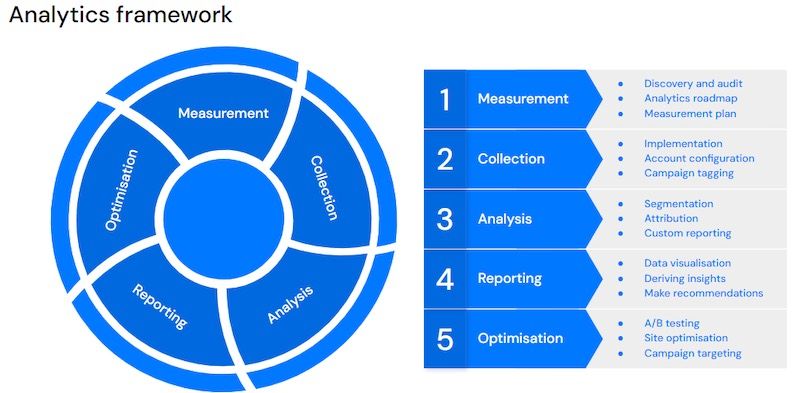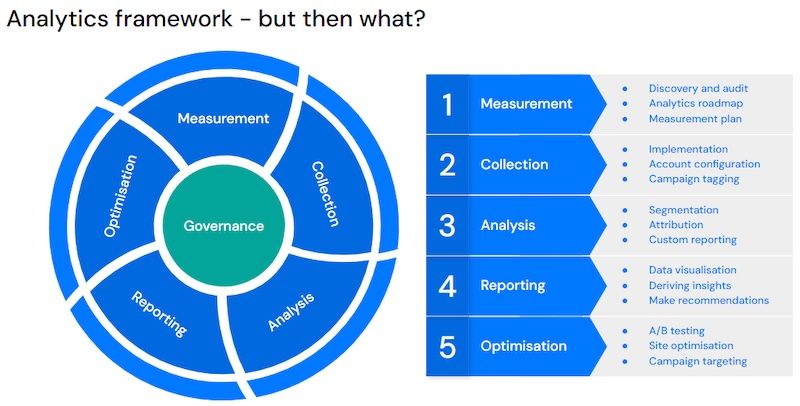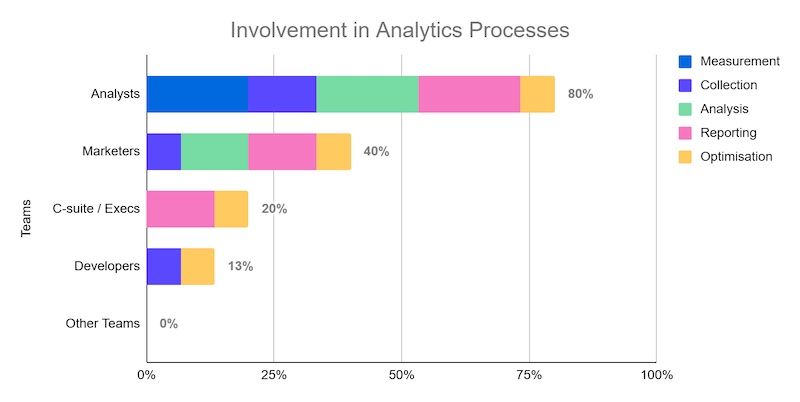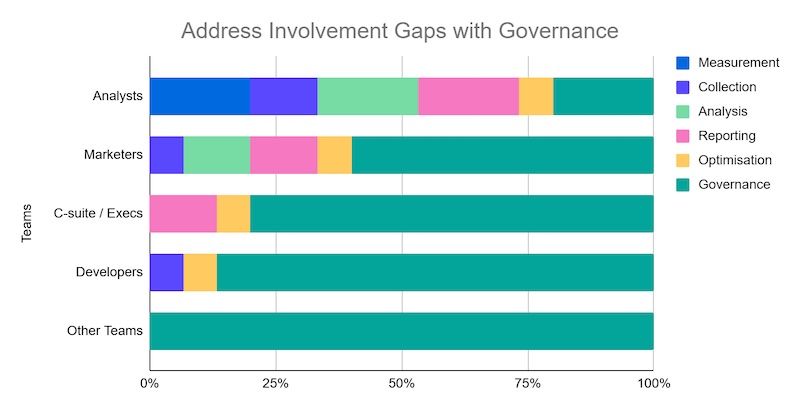Perhaps you and your team took your time carefully transitioning to Google Analytics 4 since its first beta release in 2020 or more likely, you’ve recently completed your set-up in the mad dash before the Universal Analytics sunset of 2024, either way, you may be thinking that after getting used to the reporting interface, there’s nothing more to do - but I’m here to tell you that you’re only just beginning!
If you have already been to any of our Analytics courses, you may be familiar with the below analytics framework:

It’s visualised as a wheel because it is an ongoing process - for every new change to your business model, release of a new website feature, launch of a new native app, or key learning through optimisation efforts, we must revisit the cycle from Measurement to Collection to ensure we have a solid foundation of trustworthy data that we can Analyse, Report on and seek to Optimise further.
There is however, an additional aspect of this framework that is not often addressed and that is Analytics Governance.

What is Analytics Governance?
Analytics Governance is the strategic management of your analytics tools, data access, usage, and related processes. Its goal is to ensure data quality, consistency, and security across teams. As the foundation for trustworthy insights, it sits at the centre of any effective analytics framework.
Why do we need Analytics Governance?
This might sound quite obvious but it’s something that most businesses do not dedicate time to address, mainly because it’s a team effort and requires a taskforce of folks from various business units to be done properly.
Consider this scenario where your company has:
- A data analyst who uses your web analytics data to support your marketing team but is also the only one with admin access to GA4 and has no say in what data is collected — they just make use of what’s already there.
- Marketers who aren’t sure that the data in GA4 is accurate and therefore always ask the analyst to investigate and generate reports on their behalf.
- Executives who are interested only in high-level KPIs and sign-off on optimisation efforts.
- A development team who creates the dataLayer and manages the code of the website
- An IT security team who deal with granting and revoking access for various internal systems but have nothing to do with GA4 and don’t know that a few ex-employees still have access to it.
- A legal team who have no idea about web analytics tools but are in charge of outlining the company’s data privacy policy
This means that your team involvement across the 15 core tasks within the analytics framework looks something like this:

No one team works across 100% of the analytics processes and without proper communication channels between all teams that should be involved, your website and/or app is exposed to risk and no one can effectively use your data to make informed decisions, so they end up relying on gut-feel or siloed priorities instead.
If this situation sounds familiar to you, have no fear, there is indeed a solution - governance!

What makes for successful analytics governance?
Each team in the above scenario holds a piece of the puzzle within their collective disciplines. Creating a taskforce representing each of them for Analytics Governance is the solution to fill in the involvement gaps (Note: Proportions of governance involvement are not necessarily literal in the chart here).
This is where you roll your eyes at me, knowing that cross-functional projects can be a disaster given everyone has their own ‘actual’ job to do apart from this. I hear you, so to avoid that I recommend firstly ‘evangelising’ to your key stakeholders about the importance of governing your analytics properly.
For example, is your C-suite team obsessed with how AI can be used in everything you do at the moment? Well, make sure to let them know that your Data-driven attribution and predictive audiences are fairly useless if they are based on inaccurate data as a result of poor analytics implementation!
Once you have stakeholder buy-in, ensure that each team knows their perspective is crucial in developing your analytics governance strategy and agree on the best communication channels to discuss this. If you have dedicated project managers for your technical projects, getting one of them to spearhead this process would be ideal.
Need help building your analytics governance framework?
It can be a daunting endeavour to begin, and difficult to know where the gaps are in your own approach to analytics governance which is why, at Jellyfish we now offer an Analytics Governance Workshop to help you form your taskforce and ensure you end the session with actionable strategy plans and policies.
First, we discuss what tools are in use by your company, by whom and for what purpose. Once we have awareness of the entire analytics landscape at hand, we work together to complete the first iteration of your Analytics Governance Strategy document - a simple but powerful spreadsheet that outlines each area for concern, the reason for concern, who will take ownership of it, how often those actions need to be completed as well as where and how proof of said actions are recorded.
This sheet is not meant to be a nice consulting document that you tuck away and forget about, it should be a living document to give transparency to all involved but also keep everyone accountable for their part.
We also ensure you know about all the governance features in GA4, GTM & the wider GMP stack so that it’s not as labour intensive to manage. We cover user access policies, setting up alerting and more so that your analytics governance allows you to work smarter, not harder.
Finally, If you’re looking to embed good governance alongside practical skills, the our customisable GA4 Toolkit solution offers a scalable way to train your teams, build internal capability, and drive long-term analytics maturity.

 Inspire
Inspire
